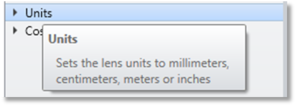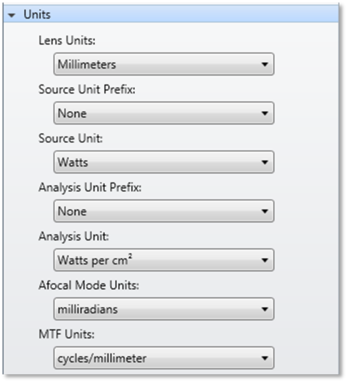Units

The Units settings are available in the System Explorer.

Lens Units:
Lens units defines the units of measure for dimensions in most of the spreadsheet editors. These dimensions apply to data such as radii, thickness, entrance pupil diameters, non-sequential position coordinates, and most other parameters in OpticStudio.
There are four choices for lens units: millimeters, centimeters, inches, or meters.
For most imaging analysis features, such as ray fans and spot diagrams, the displayed units are micrometers. The symbol for micrometers is µm. The term "microns" is also commonly used in optics. The unit micron is identical to micrometer. Wavelengths are always defined in micrometers. The choice of lens units has no effect on the wavelength units.
Source Units:
Source units define the unit of measure for the flux (power) or energy emitted by non-sequential sources. This setting is used for sources defined in the Non-sequential Component Editor, and for defining the power and irradiance in physical optics analysis. Source units may be either watts, lumens, or joules, with the additional choice of the prefixes femto, pico, nano, micro, milli, kilo, mega, giga, or tera. Watts are used for radiometric analysis, lumens for photometric analysis, and joules for energy analysis. The key difference between radiometric and photometric units is that photometric units are wavelength weighted to the response of the human eye. See the table in the next section for more information on units.
Analysis Units:
Analysis units define the unit of measure for irradiance (radiometric) or illuminance (photometric). This setting only affects data as displayed on detectors collecting light from sources defined in the Non-sequential Component Editor. Irradiance units are watts/area, where area is in square meters, centimeters, millimeters, feet, or inches. Illuminance units are lumens/area. Energy density units are joules/area. The unit prefixes femto, pico, nano, micro, milli, kilo, mega, giga, or tera are all supported.
Here is a summary of radiometric, photometric, and energy units in OpticStudio.
RADIOMETRIC, PHOTOMETRIC, AND ENERGY UNITS
| Radiometric Unit | Photometric Unit | Energy Unit |
|
Flux
watt |
Flux
lumen |
joule |
|
Radiant Intensity
watt/steradian |
Luminous Intensity
lumen/steradian = candela |
Intensity
joule/steradian |
|
Irradiance
watt/meter2 watt/centimeter2 watt/millimeter2 watt/foot2 watt/inch2 |
Illuminance
lumen/meter2 = lux = meter- candle lumen/centimeter2 = phot lumen/foot2 = footcandle |
Irradiance
joule/meter2 joule/centimeter2 joule/millimeter2 joule/foot2 joule/inch2 |
|
Radiance
watt/steradian-meter2 |
Luminance
lumen/steradian-meter2 |
Radiance
joule/steradian-meter2 |
One unfortunate convention in the optics industry (and in OpticStudio) is to use the term "Intensity" for two distinctly different things. Intensity is commonly used in ray tracing applications and the optical design community to define the flux represented by a single ray, measured in watts or lumens. Intensity is also used in the illumination and radiometry fields, but the definition used there is flux per solid angle, measured in watts per steradian or lumens per steradian (candela).
OpticStudio keeps track of energy by associating with each ray a flux value, which is equal to the square of the electric field vector also associated with the ray. When this ray strikes a detector object, OpticStudio computes the area the pixel represents to compute irradiance (flux/area) and the solid angle the pixel represents to compute the radiometric intensity (flux/solid angle). The difference in these two uses of the word intensity can always be resolved by considering the nature of the analysis OpticStudio is performing.
For more information on radiometric and photometric units, see the Handbook of Optics referenced in "What doesn't OpticStudio do?"
Afocal Mode Units:
Afocal mode units may be microradians, milliradians, radians, arc-seconds (1/3600 of a degree), arc-minutes (1/60 of a degree), or degrees. For more information on afocal mode, search the help files for "Afocal Image Space".
MTF Units:
MTF units for focal systems may be cycles per millimeter or cycles per milliradian. When using cycles per millimeter, the MTF is computed for spatial frequencies in image space on the image surface. When using cycles per milliradian, the MTF is computed for angular frequencies in object space. The MTF units selection affects the units for all MTF computations, including analysis, optimization, and tolerancing. The MTF units selection is not used in afocal mode, as afocal mode MTF always uses cycles per afocal mode unit.
Next:


